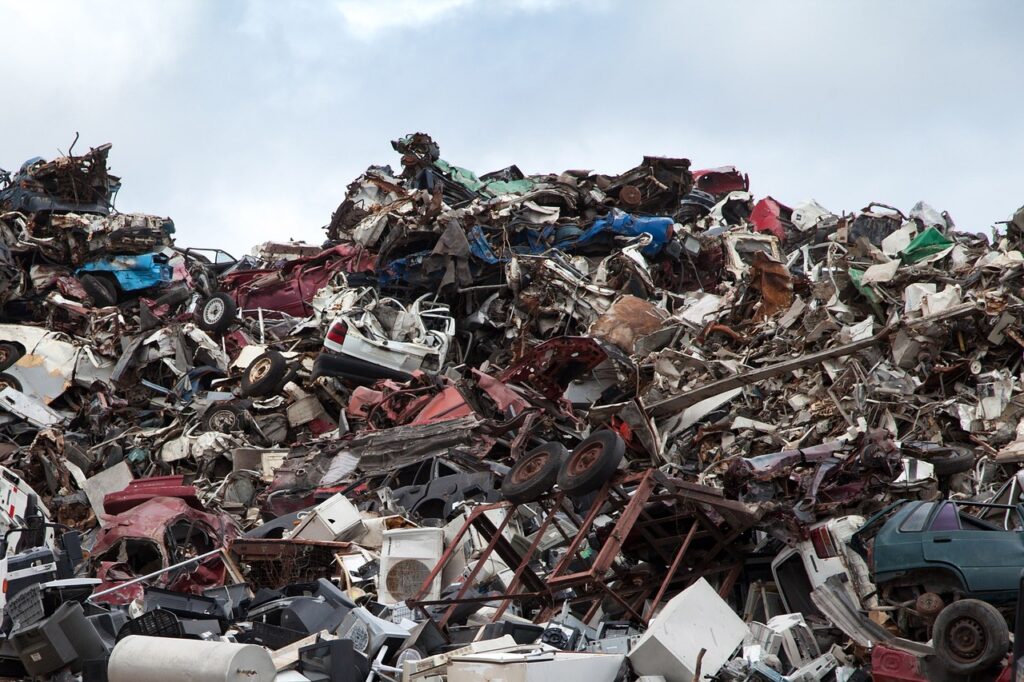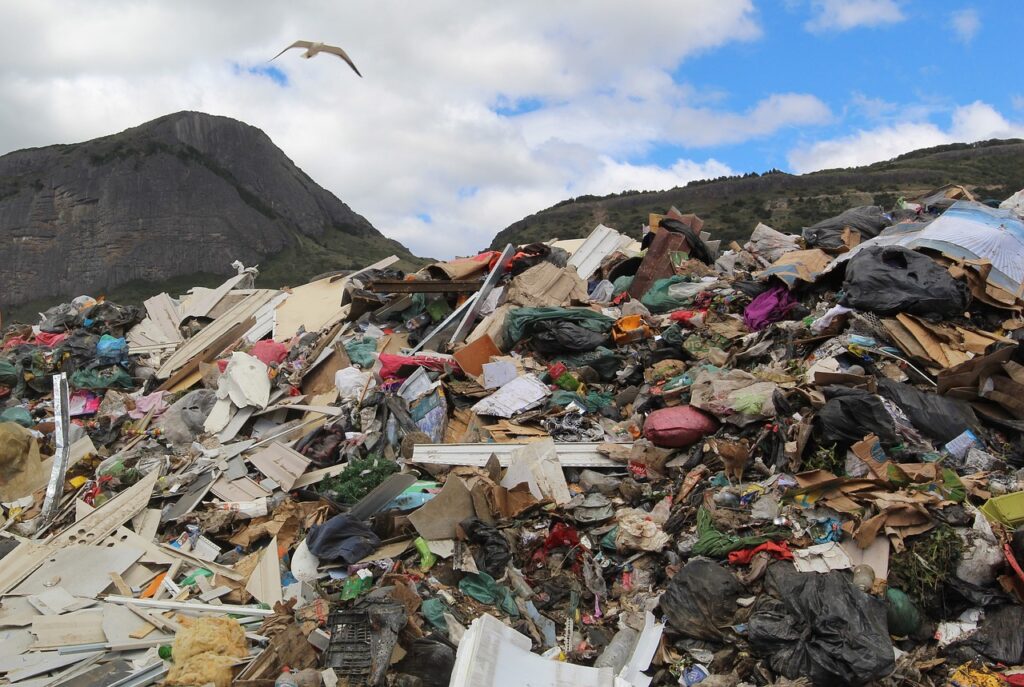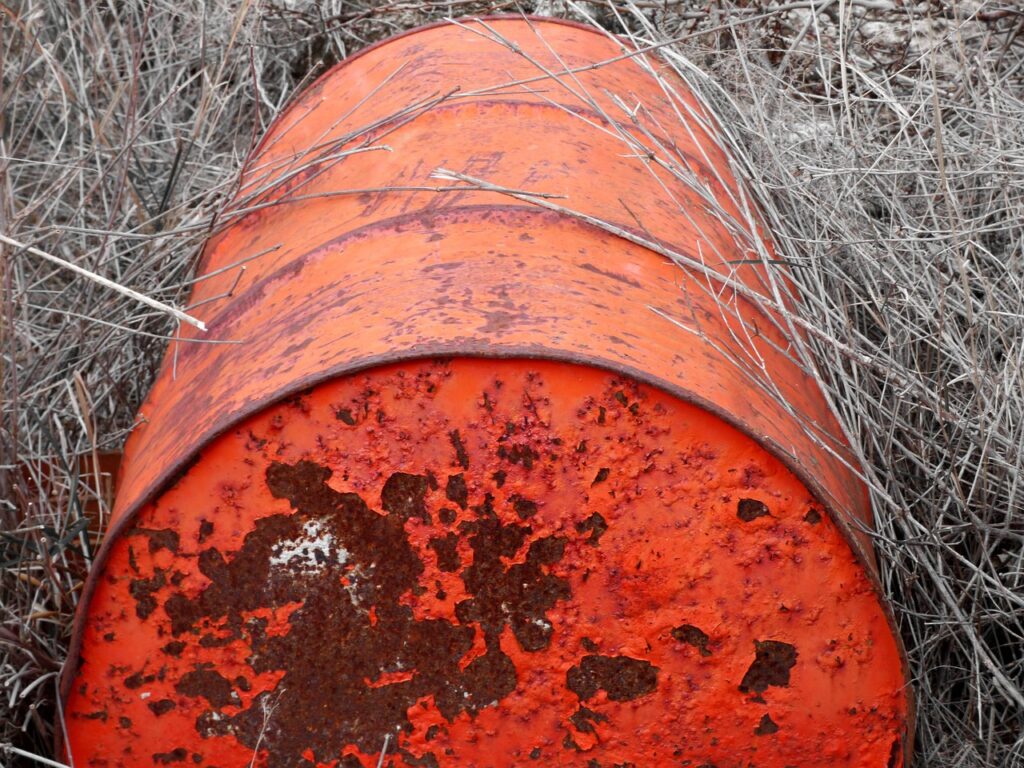…
by Rivera Sun
If you enjoy this Solutionary Climate Fiction Story, you will also enjoy Ghosts & Gleaners.
…
“That crow lady’s back.”
“She’s more buzzard than crow.”
“Magpie, I’d say. Always on the lookout for shiny trinkets.”
Peering through the grimy window, clutching identical mugs of steaming herbal tea, the three workers watched the hunched woman scrabble through the debris field of the Middens. The grass-encrusted garbage mounds towered behind her, two lurking behemoths peering down through the morning mist. The lights of the air quality monitors blinked in a steady heartbeat, signaling assurances that the Middens had not shifted in the night and belched out deadly off-gasses. The three workers shuddered at the old woman’s lack of protective gear. A pair of gloves and a face mask were her only concession to the ever-present unknowns hidden under the surface of the twenty-first century landfill.
Forty-thousand known chemicals leeched and seeped through the decaying layers of garbage bags, construction debris, and barrels of industrial waste. As the sludge eroded, a near-infinite list of chemical reactions could be triggered. It made everyone nervous.
“Mad Mags is in fine form this morning,” one worker chuckled through a sip of chicory root tea, their region’s substitute for the olden-day coffee.
The woman brandished a lichen-dotted toilet plunger at the Middens and shouted at their implacable shapes.
“Have some respect.” The voice of their crew leader startled them. Aesa Murrey drew up beside the row of bland mugs. “Dr. Margaret Pierceson was the preeminent researcher in pre-Upheaval Archeology. She founded the field of Remediation and Recovery. She held the position of Head of Middens Research longer than you’ve been alive. Don’t mock her. And don’t ever let me hear that nickname pass your lips again.”
Her use of the past tense put a second shudder down the three crewmembers’ spines. Margaret Pierceson had been a groundbreaking scientist, a renaissance woman versed in six fields of study.
Outside the window, she lifted an old cookpot and put it on her head.
“That’s not Teflon-coated, is it?” the rookie worker squeaked nervously.
Aesa shook her head. This part of the debris field had already passed through Remediation’s scans and awaited the Recovery crew’s arrival. She would never allow Margaret into the toxic edges of the Middens. Not anymore. Aesa had installed a locator in the old woman’s favorite locket and kept an eye on her throughout the day. Most of the time, Margaret tottered from her house to the debris field and back, spending the daylight hours poking around the pre-Upheaval Era oddities unearthed from the excavation of the Middens.
All civilizations have their garbage heaps. Along the coastal coves of the Dawnland, the Wabanaki’s ancestors left piles of clamshells. Across the Atlantic Ocean, Europe’s medieval outhouses coughed up the history of agriculture. Further east, Lebanon’s hill of seasnail shells testified to the Roman emperor’s demand for purple-dyed robes. Such refuse piles revealed as much about ancient cultures as their homes, tombs, and temples. What a society throws away defines them as much as what they hold onto.
These Middens had been built two to three hundred years ago by the most appallingly wasteful civilization in human history. All across the planet, they blew up mountains and drilled holes to make the stuff that they threw into their landfills. Lay researchers spun countless – and inaccurate – theories about appeasing hungry gods, or sacrificial rituals for future prosperity, or taboos against using old objects.
Aesa knew better. She’d read the pre-Upheaval records. Even as their ecological systems collapsed, the twentieth and twenty-first century societies continued to devour, consume, and discard unfathomable amounts of resources for purely secular reasons. Religious hysteria was a tempting explanation, but the truth was far more chilling: they threw mountain ranges of junk away because it was convenient.
Like their counterparts across the former United States, the Middens of Maine were stuffed full of repairable, recyclable, and reclaimable objects. Carefully processed by Remediation, Aesa’s culture would be mining the Middens for decades to come and using the recovered items for generations. Cast iron cookware. Metal filing cabinets. Hammers. Glass that could be melted down and reshaped. (Even the oddest items had new purposes. Plastic trolls – their heads empty of decayed hair – were all the rage as mini-plant pots.) The kids these days kept begging for old car hubcaps to use as toy shields, but Reclamation needed the scrap metal. Besides, make-pretend war games were frowned upon. No one had the time, energy, or money to waste on the large-scale murder of other human beings.
Image by Public Domain Pictures on Pixaby
Recently, Margaret had been collecting marbles, which had set off some snide comments about the irony of her mental illness. When she caught the culprits, Aesa made them each find a dozen marbles for Margaret as an apology gift. These quixotic scavenger hunts in the debris field were far preferable to the days when Margaret Pierceson remembered that she was a scientist, but forgot the safety protocols for entering the dangerous parts of the Middens. Aesa still had nightmares about enforcing the decision to ban Margaret from the site of her life’s work. For a long time, she thought the aging researcher would never forgive her.
But it passed. Dr. Pierceson’s anger slipped away along with the floating anxious knowing that she should be working to solve the mysteries of the Middens. She never lost her curiosity about its lurking dangers and buried wonders. Even when she lost her grip on her mind’s knowledge, Margaret still delighted in ‘discovering’ gooseneck desk lamps, salad tongs, and plastic umbrellas.
There was little that could harm her in the debris field. The local Scavengers watched out for her as they picked through the heaps for trade items. Recovery crews greeted her by her title and gently drew the old woman out of their working area by requesting her expert opinion on something in another pile. As for Teflon and other household horrors, those had already been sorted by Reclamation. Teflon was immediately sent to long-term storage containment, miles beneath the surface, below the watershed and out of reach of the aquifers. The Middens researchers didn’t let that stuff slip into the repurposing chains or the trade network. Too dangerous. Too deadly. One day, Remediation would figure out how to decouple the basic elements and dismantle the fluorocarbons. Until then, the carcinogenic cookware had to be buried like the curse it was.
Teflon wasn’t killing Margaret Pierceson, though. Not on its own. The best medical doctors couldn’t sift through her lifetime of toxic exposures. Back in the day, the gas vents spewed deadly plumes into the air, each layer they uncovered released more chemicals, and the best protection gear failed. But, thanks to Margaret Pierceson, the Middens were far safer now than they had ever been. One of her first projects had been installing filtration huts over vents to prevent noxious substances from wafting toward nearby towns. The stone buildings that masked the complex technology of the filters had frowning statues at the door, lifting a warning hand in the universal ‘stop’ gesture. These Middens Guardians encircled the entire perimeter of the mounds. After the collapses of the Upheaval, they’d learned to be pragmatic about longevity. It would take tens of thousands of years for an old landfill like this to decompose on its own. Should anything happen to the Middens Research Project, their warnings had to last beyond languages and civilizations. The message had to translate to humans who may have lost the continuity of written records and oral history, alike.
But Remediation and Recovery (R & R) intended to shorten that timeline. The Middens Research team scrambled to study the past as the other teams dug up and remedied its toxins. It was painful, despairing work. Enough to drive anyone crazy.
Including Mad Mags.
Scrabbling through the exposed heap, the old woman peeled back layers of plastic and peered at a perfectly preserved newspaper inside. The crew leader sighed and signaled to the others. R & R had missed that one. A quick Rochambeau – rock, paper, scissors – sent the loser out to catalogue the newspaper before Margaret ran off with it. All print records were screened for the Gleaners Archives so the historians and storytellers could ensure that the horrors of the past stayed there. The 20th and 21st Centuries haunted them enough already. Most likely, the newspaper was just another unexciting reprint of the advertising section – it was incomprehensible what that old society squandered trees on – but it still had to be checked. One never knew when a new discovery would turn up.
Four years ago, Aesa Murrey had uncovered the chemical formula for fracking waste jammed into an eroded metal filing cabinet. In the heyday of the fracked gas madness, the formula had been deemed a trade secret and left undisclosed to regulating agencies. Then the greedy fools had injected it into hundreds of thousands of gas wells across the continent. They’d even sprayed the waste fluids onto roads to get rid of it. The gas companies had taken their secrets to the grave. For two hundred years, no one knew exactly what was in the slurry. Fortunately, the old filing cabinet had been hastily chucked into the waste truck instead of having its contents shredded by the bankrupt fracking outfit. Aesa had wept when she found it. They could now start cleaning up the mess.
Image by Heamna Manzur from Pixabay
So much had been lost during the Upheaval. The catastrophic floods and uncontrollable wildfires destroyed countless archives. Then the server crashes of the 2040s made a mockery of the turn of the millennium’s digitization craze. It had been an unthinkable time, boggling the logical mind with its contradictions, crises, and denials. On Aesa’s shelf at home was a rare 2023 archeology book about the remarkable digs of the era. As the global permafrost thawed, as drought uncovered riverbeds, as landslides revealed the bones of buried cultures, so many astonishing discoveries had been made. But the euphoria didn’t last long. The second half of the book bemoaned the precarity of archeological storage in the climate chaos. Museum catalogs flooded in basements. Vast archives burned in fires. Widespread disasters ravaged collections.
The irony of unearthing the past at a time that had no hope of a future was not lost on Aesa. Timing was everything in those books published in the 2020s. Seven years earlier, nothing shook the hubris of their civilization’s sense of infallibility; nothing rattled the archeologists’ assumption that their work would enjoy longevity. Seven years later, no one – archeologist or otherwise – had time to write books. Everyone was too swept up in trying to survive the climate crisis. By 2040, the field of archeology as they knew it would largely disintegrate. Not until 2100 would it re-emerge, this time in three distinct fields: the Gleaners, the Redeemers, and the Remediators.
The Gleaners studied the past to prevent its mistakes from repeating. They were a quasi-spiritual, semi-civic field that blended meditation and ancestor communing with more scientific research, archival research, and archeology. Aesa had trained with them as a young woman, but found the role of community leadership burdensome and intimidating. It had been a relief when her Gleaner mentor had suggested she move into a more research-oriented position.
The Redeemers – or Dreamers as they were called – took her under their wing next. They encouraged her to tinker with the technology of the past for safer applications in the present. She’d helped them fix the intake valve on the waterwheels at the Hook-up to keep fish from getting caught. They’d adapted the concept of street lamps to run on glowing algae bowls tended by a Lamplighter with a specialization in microalgae. Their definition of ‘tech’ was broad, of course. They also reworked collections of folktales to teach peace and problem-solving rather than violence and punishment. They revived long lost games for the children to play, shifting the rules to foster cooperation, rather than the competition of the older times. It had been a heady period of Aesa’s life, full of all-night conversations and two o’clock in the morning bursts of inspiration. Aesa had loved working with the Dreamers to salvage the gifts of history in ways that ensured a better future.
As for the Remediators, Aesa never thought she’d work with them. It was too dangerous, too frightening, too thick with failures. The effort to clean-up the mess of one short century – from 1950-2050 – was noble, but utterly heartbreaking. Most people tried to ignore the scope of contamination. Everyone learned a little bit about it in school, right after the segments on genocide, colonization, and nuclear bombs. They learned about lead in paint and water pipes, asbestos insulation, Teflon cookware, forever chemicals in flame retardants, hexavalent chromium, benzene-laced wastewater. The sheer scale of contamination gave everyone nightmares. Mapped across the former United States with color-coded overlays, there was hardly a place left to stand. The cancer rates of that hundred-year period were enough to induce panic attacks in students. One out of three people got sick, many died, all were subjected to the barbaric, painful, and expensive treatments of the period. Women would cut off their breasts just to survive. And cancer was just one of the dangers of the chemical contamination. There were also neurological disorders. Birth defects. Degenerative diseases. Chronic illnesses. Ecological collapse. Extinction of species.
The psychological toll alone was reason enough to stay away from R&R. The Healers kept a close watch on the workers; depression was common among them. For every toxin they learned to neutralize with algae and fungi, they discovered some other lurking chemical monster. Aesa had wanted nothing to do with this field.
Then the letter came, summoning Aesa home: Her mother was sick. Her father was dying. Her younger brother already dead.
They’d thought they were safe, miles away from the Middens. The towering mounds could not be seen even from the top of the tallest hill. They’d done the tests of the water, air, soil, and found only the usual levels of contaminants – nothing was pristine after the carnage of that century – but the ground shifted. A seam opened. In the depths of the Middens, a barrel of old farm pesticides cracked its crumbling iron rims. The seepage hit a leaking pile of buried paint cans. The chemical reaction gnawed through the rock, hit the vein of their watershed, crept into the well they’d tested. Day after day, the water burrowed its toxins into them, one sip at a time. Every pot of lentils. Every loaf of bread. Every cup of tea. Every shower. Every time they washed the dishes. Every bucket of water splashed over the head on a hot day.
Aesa lost her whole family in two years. The guilt never left her. While she’d been in another town, inventing the future with the Dreamers, they’d been dying.
I should have been there, she told her friends.
You’d be dead, too, they pointed out.
I would have noticed something was wrong, she argued, I could have done something, I could have saved them.
Grief subsumed her in its downpour. Rage shuddered through her bones. The Dreamers urged her to pick up her work again, she couldn’t. The 20th Century records ignited nothing but fury in her now. A hatred burned in her, hotter than the forest fires of the 2010s. The Gleaners took her back for a while, but she snapped one day and trashed the archive room in a fit of rage, hurling boxes off the shelves, toppling cabinets. If she’d had a match, she would have burnt the Archives to the ground. The Gleaners banned her from the building.
Image by Marc Pascual from Pixabay
Aesa walked out into the woods for a summer, unable to bear the hints of those poisonous ancestors lurking in the games of the children, or in the mechanics of solar generators. She hated humanity, hated the narcissistic conceit that left a legacy of ecological chaos and toxic waste. For a whole summer, she lived in silence in a small, hand-built hut, visited each week by a Healer. She swam in the nearby lake and tried not to worry about a poison-seam opening in its depths. She bartered wild blueberries for flour and lentils and hoped they weren’t full of forever chemicals. She endured the swarms of mosquitos and tried not to let her skin crawl over imagined rashes caused by unknown toxins.
She might have lived there forever, or at least until the bitter winter killed her with cold, but on the day the first frost laid its lacy fingers on each blade of grass, Dr. Margaret Pierceson came to visit her.
The renowned researcher did not seem mad, not back then. Dr. Pierceson’s brown, gray-streaked hair was tidily piled on top her head with a pencil stuck through it. A pair of reading glasses – vintage, plastic-framed – hung on a string around her neck. Old watches adorned each of her sun-browned wrists. One, a gold-plated, square-faced beauty from the 1920’s, had been meticulously restored and ticked away silently. The other, a 2020 smartwatch with no hope of repair, clung to her wrist with a cracking plastic band, reminding Dr. Pierceson of the folly of believing in the infallibility of tech. There was no room for such hubris in these times.
Margaret had already seen the early signs of her mind’s crumbling. Consummate scientist, she established a baseline, and proceeded to dispassionately watch the occasional patches of fogginess spread. Nothing alarming, just a slightly slower recall of the atomic structure of cadmium or a delay when she tried to remember the Latin nomenclature of a certain plastic-eating fungi. Little things that rarely bothered the average mind.
But Dr. Pierceson did not have an average mind. She had an eidetic memory. An analytic capacity that rivaled the operating systems of the Late Aughts. An intuitive hyperfunction that leapt to understandings it would take her colleagues years of meticulous research to finally prove and explain.
She knew her mind was going the day she lost a game of Go to her colleague. He chalked his win up to luck, but Dr. Pierceson quietly began her observation log that night. Two years later, the progression, though manageable, was undeniable. She lost her reading glasses unless they were stung about her neck. She left the tea kettle boiling to bone dry if she didn’t flip the whistle-lid down. She made an entry-level error in her calculations. Without fanfare, Dr. Margaret Pierceson began preparing for the final chapter of her life. She delegated key research duties. She turned down over-ambitious projects. She stepped away from her leadership role in the Association of Remediation and Recovery, claiming she needed more time for her research.
About that time, she’d received a furiously scrawled, tear-stained, handwritten letter from a young woman named Aesa Murrey.
How could you let this happen? How could you let my family die? You are the Head of Middens Research. You’re responsible for safeguarding us from its dangers.
Aesa had sent it off in a fit of despair and rage, desperately flinging blame in any direction it could stick. She did not expect a reply and she certainly never imagined that the short, sharp-eyed scientist would show up at her hut.
Margaret Pierceson had no tolerance for fripperies, foolishness, or polite niceties. She had no time for beating around the bush. With the cries of migrating geese calling mournfully over the trees, she spoke plainly to the girl.
“I am sorry for what happened to your family. No matter how fast we learn, no matter how much we know, it is never enough.”
To her horror, in front of this snarl-haired, smudge-cheeked, stony-faced young woman, Dr. Pierceson sank down to her knees in the rough shelter and wept.
Image by Rondell Melling on Pixaby
Mortality reared its scythe. Frailty shuddered under her skin. The fleeting light of autumn touched her eyes. Time. There was never enough time. Even if she lived to a hundred, what good was that compared to the timeline of these chemicals? Epochs would rumble past before the toxins decayed. Humanity would evolve or extinguish long before its plastics eroded. Margaret had only a brief handful of years left before her mind crumbled, years of faltering capacity. She felt the weight of all that was left undone, all that she would not accomplish before the end.
Aesa Murrey watched the Head of Middens Research sob into her palms and did the only thing she could: she made a pot of tea.
Aesa set her sole mug in Margaret’s trembling hands and poured another measure into her only bowl. Together, they took a sip in silence. Then another. By the third, they regained their voices and the capacity for words.
“I am ill, Aesa,” Dr. Pierceson confessed. “No one knows except my doctor. But they will. Soon. It will become obvious to everyone.”
“Why are you here?”
Aesa’s voice held a hint of bitterness, a brush of awe, and a gulp of confusion. The younger woman could not fathom what had brought this renowned scientist all the way out here. It was a long journey by horse-drawn coach or solar train. Dr. Pierceson would have to spend the night at the guesthouse in town.
“I want you to come work for me.”
“If this is out of pity -” Aesa erupted, insulted.
“It’s not. Hear me out.”
Perhaps it had been pity, at first, or charity, or guilt that her team had not prevented the tragic deaths of Aesa’s family members. But then Dr. Pierceson examined Aesa Murrey’s file. Gleaners and Dreamers both sought her out, the past and future called to her. Aesa had an aptitude for research and archival investigation, a background in chemistry, engineering, biology; an interest in history and cultural studies. Her former coworkers spoke highly of her, even despite her ransacking of the Gleaners Archive Room.
Aesa might be lost . . . but she could be found.
“Come work for me,” Dr. Pierceson urged her.
“I can’t,” Aesa stammered. “I hate that place too much. The Middens – you have no idea.”
But Margaret Pierceson did have an idea. She, too, had lost colleagues over the decades of her research efforts. Her lab manager was irradiated at an unmarked nuclear waste site. Her intern accidentally inhaled cyanide at an uncapped vent location. One of her workers died of chemical burns when a hidden frack waste container crumbled underfoot.
“We all hate that place,” Dr. Pierceson told her. “That’s why we work there.”
Not today, or tomorrow, but someday, the Middens would be gone. Every trash bag. Every broken television. Every rotting baby diaper. The fungal treatments would devour the plastics. The microbial washes would break down the toxins. Recovery would find new homes for all that could be saved.
“One day, Aesa, the Middens will be no more. A pair of meadows will grow in their place. And do you know what will stand in these meadows?”
The young woman shook her head.
“A memorial to all the people those toxins killed, the countless millions who died of cancer, neurological illnesses, degenerative diseases. My colleagues. Your family. Me.”
It would not be a stone memorial with dead names carved into lifeless lines. Instead, wildflowers would honor them: daisies, buttercups, yarrow, asters, Queen Anne’s Lace, colt’s foot, meadowsweet, cinquefoil, pearly everlasting, goldenrod, heal-all. Year after year, they would bloom, dedicating their short and beautiful lives to nectar and pollen; nourishing bees, birds, butterflies, insects, and all the animals that depended upon them. They would rise and perish and rise again, weaving sunlight and rainfall into the quiet miracle of a meadow.
Dr. Margaret’s voice grew soft and tender.
“There will be children among those flowers. Safe, happy, healthy children.”
The scientist’s sharp brown eyes, shadowed with knowledge of fleeting time, sought out the young woman’s.
“These children will be there one day because we were here today.”
In the dangers. In the toxins. In the mess. In hope, in fear. In love, in loss.
The future of our dreams cannot come unless we awaken.
Image by Rolanas Valionis from Pixabay.
Aesa gathered her belongings and followed Margaret Pierceson toward the vision of those Meadows. She faced down the nightmare of the Middens and confronted the specter of her ghosts. She learned how to transform the monstrous toxins into the harmless elements of life. She saw the mounds slowly diminish, year after year. Margaret’s vision would take longer than both their lifetimes, but each day, Aesa saw it come closer.
By the time Aesa became a crew leader on the Middens Research Project, Margaret had long since retired. White-haired, filmy-eyed, the old woman would wander the Middens’ edges in her battered boots, muttering made-up incantations to ward off fluorocarbons. She scavenged plastic action figures and turned them into shrines, worshipping deities that only she could name. When she lost reliable motor control, Aesa moved into Margaret’s spare room to help care for her. Each day, she brought the researcher a gift of reclaimed objects from the Middens. A set of records for the old turntable. A pile of 1980s polaroids. A box of Legos. Together, they ‘rediscovered’ their stories, inventing research that Margaret would forget within minutes. Aesa shared the progress the R&R team was making on breaking down old paints. She showed her the blueprints for an early detection system to prevent watershed contamination below ground. She told Margaret how the rookies were shaping up and how the old-timers were holding on. As Margaret’s mind slipped loose of its moorings, the Meadows were the last anchor that remained.
In the end, when Dr. Margaret Pierceson drew her last breath, Aesa was at her side murmuring stories of the Meadows. She recited the names of the flowers and the songbirds, the insects and burrowing animals. She invented prayers of sunlight and rainwater. She described winter’s hush of snow and spring’s burst of green. She sang lullabies of bees wings and coyote howls. She told sagas of field mice and fox kits. Margaret always grew calm in the telling. No pain or discomfort could disturb her so long as these images were invoked in her mind.
When the Middens researcher finally slipped out of life, the Meadows were the heaven that welcomed her home.
__________________
This Solutionary Climate Fiction Story was written by Rivera Sun. If you enjoyed this, you will also enjoy Ghosts & Gleaners.







Mariel Hess
says:Another beautifully crafted story, Rivera – so prescient of the self-destructive devastating direction we are going, yet so full of hope. Thank you.
Margot Vos
says:I am reading and watching more stories like this.. Stories that bring us into the reality of what’s to come but bringing it into human scale. Watching Extrapolations on Apple TV – is an initiation that stays with me daily. I feel the biggest challenge for those of us who can see what’s coming is to create a way for others to understand on a human, personal scale. Thinking about our whole planet changing all at once is just too huge for us to really take in. I feel we need many more stories like this one to help people wake up to the reality of our situation. Keep writing Rivera!!! I know you will. Your work has inspired me in so many ways to keep teaching, to keep healing myself and others.
Blessed Be,
Margot Vos RN